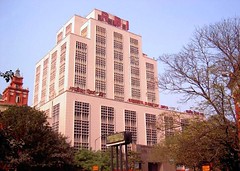
Pune-based real estate developer Mr Nitin Nyati has made a foray into the hospitality segment with the launch of the Corinthians Boutique Hotel.
Mr Nitin Nyati, Chairman-Nyati Group, said, “Entering the hospitality business was a logical extension of our existing Club business. After market research and analysis, we decided to create a destination hotel.”
The group, which has formed Nyati Hotels and Resorts an SPV for the business, has invested Rs 120 crore in the boutique hotel. It has also firmed up plans to launch another property with sixty spa villas at Khadakvasala and build a second boutique hotel on the Pune-Bangalore highway. “In time we want to go nationwide with the concept,” Mr Nyati said.
Located on a hill-top, the 120-room Corinthians Boutique Hotel has been built in a Moroccan style with Greco-Egyptian elements of architecture. Among the highlights is the Brew House pub having an attached brewery that can brew 200,000 litres of fresh beer in a wide range of varieties.
Monthly Archives: October 2009
Nyati Group enters hospitality business
Debt clearance likely to use up a quarter of realty IPOs

Nearly a quarter of the Rs 11,665 crore funding that five real-estate companies plan to raise through IPOs will be used to re- and pre-pay debt.
Emaar MGF Land, Ambience Ltd, Lodha Developers and Kumar Urban Development have earmarked a part of the IPO proceeds for loan repayment. Sahara Prime City plans to invest the proceeds only in construction and development of projects, as well as general corporate purposes.
According to the preliminary draft prospectus filed with SEBI, Emaar MGF Land intends using about Rs 1,972 crore for debt repayment and prepayment under two heads. It wants to repay Rs 1,772.6 crore of its outstanding debt from the IPO proceeds and de-leverage the balance-sheet. Its lenders include LIC, Axis Bank, LnT Infra Finance Co, HDFC Ltd and UTI MF. Other lenders are SBI, HSBC Ltd, Bank of India, Standard Chartered Bank, Citibank, IndusInd Bank and Kotak Mahindra Bank.
Additionally, it plans to use Rs 199.5 crore to fund Emaar MGF Construction for repayment and prepayment of loan facilities. The modalities of funding Emaar MGF Construction are yet to be finalized, but could be via both debt and equity. The remaining proceeds of the IPO would go towards development charges and license renewal fee, redemption of preference shares and general corporate purposes.
Ambience Ltd, which is developing commercial and luxury residential complexes in the National Capital Region, wants to prepay up to Rs 475 crore of outstanding loans. The rest would go for the development and construction of projects such as the Caitriona condominium complex (Gurgaon), an office complex at Ambience Island Township (Gurgaon) and Ambience City township project (Panipat).
Mumbai-based Lodha Developers proposes to use Rs 299.3 crore from the IPO proceeds to fund subsidiaries that have taken loans from various banks/financial institutions. It would deploy Rs 1,833 crore for the construction of eight ongoing and planned projects.
Kumar Urban Development, which is present in Pune, Mumbai, Bangalore, Hyderabad and Nagpur, plans to use about Rs 200 crore from the IPO proceeds to repay loans. The remaining amount from the Rs 450-crore public issue will be used to acquire land development rights and for construction costs.
Dubai to host IndiaHome

The IndiaHome Property Exhibition, which helps the Indian get information on a range of residential real estate opportunities in India, will be held in Dubai from 9th to 11th october 2009.
The exhibition invites builders from across India to present their projects under construction and will showcase Emaar MGF, ETA Star, Hiranandani Constructions and Raheja Corporation. The cost of the properties showcased is likely to be in the range of forty lakh to ten crore rupees.
Mr. Ashish Mehrotra, Head Consumer Assets- Citibank, said, “Owning a home in India is a long-cherished desire of all NRIs worldwide. Our endeavour with the IndiaHome Property Exhibition is to create a convenient interface for NRIs with India’s reputed real estate developers and help make the purchase process flawless”.
Further he added, NRI customers can avail loans ranging from twenty lakh to five crore rupees for ready-to-move and under-construction properties which can be obtained under flexible payment plans and periodic payments can be conveniently routed through the Citibank NRE/NRO Account.
Interest rates on home loans decline further

An interest rate war is brewing in the home loans this festive season. Development Credit Bank (DCB) and GIC Housing offering home loans below the psychological 8%. DCB, which recently entered the segment, is offering home loans at 7.95% for loans up to Rs 5 crore at fixed interest rate for the first year and floating rates from year two.
“While affordable housing is the buzzword these days, the market would get a further boost if attractive financing options are available,” says Praveen Kutty, executive vice-president and head, retail banking, DCB.
Central Bank of India and Punjab National Bank have waived off processing fee and documentation charges on certain loans. While one would argue that there isn’t much difference between 7.95% and 8% home loans, bankers say that it is basically a psychological pricing to get more borrowers into their fold.
According to bank observers, borrowers prefer low interest bearing home loan accounts of nationalized banks over private banks. “While there has been demand for home loans in the affordable home loan segment (up to Rs 30 lakh), the activity in the upper bracket (loans above Rs 50 lakh) has mostly revolved around restructuring or takeover of such accounts by another bank,” says VS Reddy, managing director, Lakshmi Vilas Bank.
Looking for SEBI norms for REITs

PE investors in real estate projects are waiting for SEBI’s REIT Regulations so that they get an exit option once their investments mature.
In the absence of REIT regulations, PE investors are unable to unlock the investments made in realty projects in the last 4-5 years. An estimated 3 – 4 billion dollars investments mostly at the project level, majority of which came through the FDI route, are awaiting exit options like REIT or REMF.
Though SEBI had issued draft REIT regulations almost 2 years ago in December 2007, it has not yet made up its mind on the final regulations.
Even in the case of REMF scheme, which was notified in May last year, the regulator has held back permission to a couple of entities – HDIL Constructions and Kumar Housing Corporation.
Valuation of realty by accredited valuers is yet to be sorted out, since SEBI has not issued a list of real estate valuers.
REITs have become a preferred vehicle for investment in properties around the world. Global market for REIT is estimated at over 450 billion dollar with Asia alone accounting for seventy billion dollar market share.
Al Wa’ab City walks ahead luxury Oberoi Hotels and Resorts

Oberoi Hotels and Resorts has received numerous prestigious awards. The Oberoi brand is synonymous with providing the right blend of luxury, warm service and quiet efficiency to international luxury travelers. It is acknowledged by business and leisure travelers alike as being amongst the finest in the industry.
The Oberoi Hotel, Doha will provide its guests, residents and visitors to Qatar with a distinctive luxury hospitality experience, featuring 225 rooms and suites, 30 serviced apartments in addition to premium outlets for fine dining, leisure and health amenities.
Sheikha Hanadi Nasser Bin Khaled Al Thani- CEO of Al Wa’ab City Management- said, “This MOU is a great example of how Al Wa’ab City is consistently aiming at achieving growth and excellence and remaining true to our mission and commitment to being Qatar’s leading real estate developers. The goals we set at the beginning of our project are being realised across the board and our strategies are continuously enhanced to respond to the changing market environment. Oberoi Hotels & Resorts is perfectly in line with our vision to bring home an unparalleled showcase of the most premium experiences”.
She further added, “Since the launch of our project, we made sure to build our momentum by defining and meeting numerous benchmarks. To sign an MOU with a group of Oberoi Hotels and Resorts’ exceptional quality and character is exactly the level of association we expect the Al Wa’ab City project to be aligned with. I’m sure this will be a great partnership, we look forward to welcoming the Oberoi hotel in Al Wa’ab City and the city of Doha”.
Safexpress investing in 32 logistics parks
Safexpress will invest nearly Rs 600 crore in the next two years to launch 32 logistics parks to double its warehousing space to around ten million square feet.
According to Mr Vineet Kanaujia, GM, Marketing, Safexpress, The expansion will help the company reach revenue of around Rs 1,000 crore in the next two years from Rs 650 crore.
Nearly one third of the new investment will be in the South.
The company announced its new logistics park in Chennai at the Logistics 2009, a two-day seminar on logistics, organized by the CII Institute of Logistics.
It has invested Rs 35 crore in the 3.86 lakh square facility, located at Vanagaram on the NH-5.
The park enables loading and unloading of 134 vehicles simultaneously to ensure smooth and uninterrupted movement of goods, he said at the sidelines of the event.
Domestic land near Gomti Barrage to turn commercial

The UP government is all set to give its formal nod to change in land use of reclaimed land between the Gomti barrage and the eight-lane bridge. The 8 acre of land would soon have its land use changed from open space to commercial.
The Lucknow Development Authority has already given its approval to the change in land use and the matter is set to be put forth before the Housing and Urban Planning department of the state government soon.
The once degraded land has turned into a precious plot after the irrigation department constructed a bandha along the Gomti. As per the proposal put forth by the land acquisition wing of the LDA, the land is shown as an open space in the Masterplan-2021. ‘‘Disposing this land with the present land use would not fetch enough revenue. The land could instead be used as commercial as the area around it has high commercial activity,’’ the proposal put forth by joint director (land acquisition), LDA, S B Mishra said.
The proposal further said that reclaimed land between La Marteniere and the eight-lane bridge is proposed to be converted into a open space and green belt for which the state government would be required to spend Rs 100 crore. The proposal added, “This amount can be recovered if the reclaimed land between Gomti Barrage and eight-lane bridge is disposed after converting its land use into a commercial one”.
Interestingly, this piece of land appears to have become the axis around which all development activities in the area spin. To begin with, the connecting bridge — between Lohia Path and Tilak Marg — along the land is being widened. Likewise, a six-lane road close to it is being constructed at a swift pace. The two roads would certainly ease the traffic situation, admitted well-placed officials in LDA. The proposed construction of a Barrage further downstream of the Gomti is the latest addition. The said reclaimed land is downstream of the Gomti Barrage, which controls the flow of river. Often, the water current along the stretch is too feeble making the river view pathetic. But once the new Barrage comes into existence and the Gomti Barrage becomes redundant, the water current along the stretch would be good enough, bettering the view.
In fact, the new Barrage is believed to be constructed some six kilometer downstream, in what officials claimed was part of the Gomti river front development project.
Checklist for NRIs Willing To Invest In Real Estate

1. Doing a bit of research on the track record of builder can help.
2. For any real estate purchase it is preferable to make visits to the sites before buying them. This exercise is worth it not only because we are committing a large amount of money but also because reversing the decision proves costly as well. If the NRI is not able to make it, he can request a trusted friend or relative to opt for the site visit.
3. Going for a home loan through a bank will ensure that the money is released in stages only. This keeps the money safe during the construction. Also, all the banks at their local branches have their list of shortlisted builders for whose constructions loans are pre-approved. It is better to buy only these constructions, as the banks are quite stringent in their norms for pre-approval and shortlist only those builders who have a proven track record and those project, which comply to all legal norms.
4. Post the construction, the management of the asset is one of the major issues faced by NRIs. There is no easy solution for this. There are some society associations which support the owners of the buildings with services like maintenance and rent collection. There are again the “friendly neighborhood real estate agents” who may some times double up as the maintenance manager too. Many times though the “friendly” turn into “greedy” after some time. There are a few professional real estate management firms in most metros, which are now expanding into the Tier-II cities too.
5. Some of the other checks for any real estate purchase are:
i. Whether the construction rate quoted is for Built-up area or Carpet area? Construction is generally quoted for built-up area and rental is quoted only for the carpet area. There can be a difference of 15 % to 20% between the two based on the type of construction. Today in apartments there is the concept of super built-up area which apart from the built-up area includes stair case, common passages, fire escape passage, etc. The super built-up area can be bloated by as much as 50% of the carpet area.
ii. Robert Allen, the Real Estate Mogul suggests the 100 – 20 – 10 – 1 rule for any real estate purchase. The idea is to check out 100 properties in person; shortlist 20 of them for a deeper scrutiny; enter into negotiation with sellers for 10 of the properties and finally buy the ONE that is best suited.
iii. Technically there should be a check for all the statutory approvals – town planning, water supply and sewage disposal, safety approval from the local fire department, etc. It is always better to ask for the encumbrance certificate and the title deed from the builder to get a legal opinion from a lawyer.
6. Don’t hesitate to ask. This is probably the most important point. Many times, for avoiding being thought of as less intelligent, we question less. For any investing and particularly for real estate the more the questions asked the better the investment. The genuineness of the promoter can be gauged by the patience, the promptness and depth of the answers. Answers like, “Don’t worry about that, we will manage”, without going into the specifics are danger signs.
7. Take time. Do not restrain yourself by limiting the time for checking the properties and decision making to the time that you are present in India. A 2-4 week holiday cannot be hoped to be converted into a real estate investment period. Start the process before you come here. In case you cannot decide before you leave, it is OK. A Power of Attorney to a parent or a relative can be used to decide on the actual purchase even after you leave the shores of India.
A Model real estate bill by housing ministry

For promoting a planned and healthy real estate development of colonies and apartments in big cities, Union Housing and Urban Poverty Alleviation Ministry has drafted a bill and invited suggestions from experts.
Kumari Selja-Housing and Urban Poverty Alleviation Minister- said, “The government has taken a major initiative in the shape of a model Real Estate (Regulation of Development) Act for which the ministry has held preliminary discussions with various stakeholders”.
She added that a draft bill to promote planned and healthy real estate development of colonies and apartments, with a view to protecting consumer interest and facilitating smooth and speedy urban construction, has been placed on the website of the ministry for comments from experts and public.
The ministry is also encouraging institutionalized financing and formal channels of credit.
Gujarat Realtor Radhe Moves Toward South

With “green shoots” becoming a byword for the ‘receding recession’, a new pattern may be emerging in the realty sector of South India — sell-out properties lock, stock and barrel, or reduce financial burden by signing up a joint venture wherever possible. This may lead to consolidation in a sector seen as rather unorganized.
The Gujarat-based realtor Radhe Developers (India) Ltd, listed on the BSE, offers one such example. It plans to invest around Rs 175 crore in Kerala and Andhra Pradesh to develop a resort and high-end residential villas, respectively.
In Kochi, the Ahmedabad-based company will invest about Rs 60 crore from its internal accruals for buying out the resort spread over five to six acres and spend another Rs 15 crore on its renovation, through a debt. The renovated resort would start in a year’s time, he said.
By entering into a 50:50 joint venture with Jayadarsini Housing Pvt Ltd of the Gorlas Group, Radhe Developers plans to invest nearly Rs 100 crore in the ongoing project of developing a 500-acre property of residential villas near Hyderabad, in the next five years.
It comprises construction of 805 independent villas, of which 398 would be developed in the first phase in 90 acres.
In Gujarat, Radhe Developers plans to take up an ambitious Rs 12,000 crore project in Vadodara district where it has identified 1,000 acres for a massive, integrated township. Altogether 33,329 residential units have been planned by the company, which has already acquired 498 acres of land, Mr Patel said, adding the company was now awaiting the State Government’s proposed announcement of township policy to start work.
RBI may hike key rates early next fiscal

The central bank may unwind its accommodating monetary policy by hiking key rates in the first quarter of financial year 2011.
The Reserve Bank of India could resort to monetary tightening to counter the liquidity pressure that could emerge from the expected pick-up in credit in the busy October-March season and Government (both Central and State) borrowings in the second half. Further, it could also help stem the rising inflation.
As of now there are no concerns on account of liquidity — banks have collectively deployed surplus aggregating about Rs 80,000 crore (on October 1) at the RBI’s reverse repo window and almost Rs 1.50-lakh crore in liquid schemes of mutual funds. However, inflation, which at least in Wholesale Price Index (WPI) terms is currently benign, is slowly rearing its ugly head.
Bankers, however, see pressure building up on these two fronts from the beginning of the new financial year.
Once credit demand gathers pace, banks will unwind their investments in reverse repo and mutual funds. In the financial year so far (April 1 till September 11), credit uptake by various segments of the economy from banks was tepid at Rs 50,408 crore (Rs 1,33,644 crore in the year-ago period).
“Given the current liquidity position, banks can comfortably meet the demands of trade, industry, agriculture and retail segments,” said the treasury head of a public sector bank.
However, inflation is a cause for concern for both the Government and the central bank and this could force the latter to tighten the rates in the first quarter of FY2011, said the banker.
The WPI, which has nudged up to 0.83% in the 12 months to September 19, above the previous week’s annual rise of 0.37%, is expected to touch 6% by March next.
A Nomura report said, “We expect both growth and inflation to surprise on the upside in the coming months. As such, we maintain our view that the RBI will hike its repo/reverse repo rates and CRR by 125 basis points each by end-2010.”
Realty player RE/MAX in Gujarat
Real estate brokerage firm RE/MAX has commenced its Gujarat operations and plans to set up one thousand offices across India in the next five years, according to Mr Samir Chopra, Director. He said, “At present we are in Kerala, Tamil Nadu, Karnataka, Pune, Chandigarh, New Delhi and NCR. We will first go into the big cities and then tier two cities”. Further he added that the global firm has a presence in America, Europe and Australia and is now slowly moving into BRIC countries.
